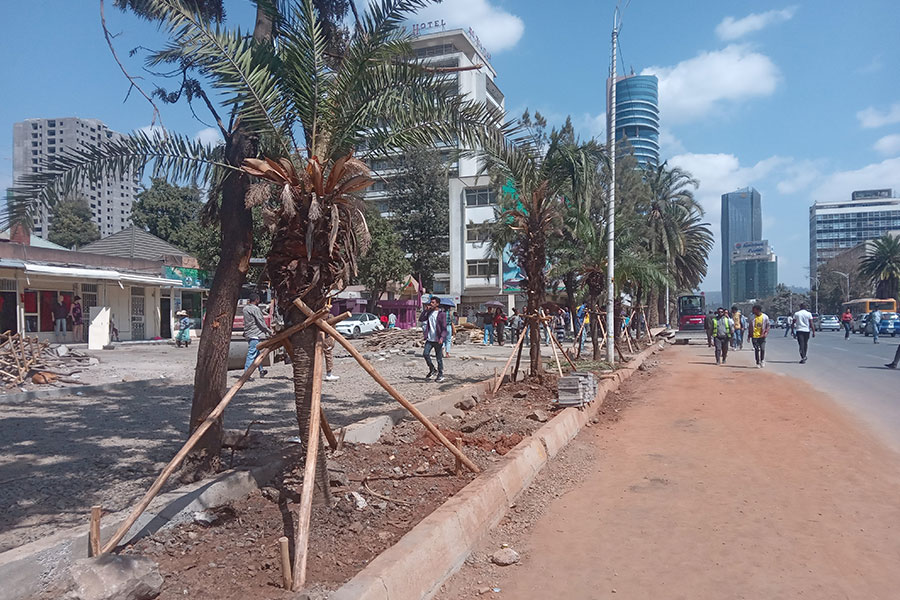
Fortune News | Sep 14,2024
Dagmawit Yilma, a mother of three young boys, knows the struggle of Ethiopia's energy crisis all too well. Simple tasks like making breakfast and preparing school lunches have become a daily ordeal thanks to the persistent power outages. With the rising cost of living, affording charcoal for cooking has become difficult. "My TV also broke down," she said, explaining how power surges destroyed her 55-inch Samsung. Her refrigerator has become unreliable, leaving her family with spoiled food far too often. Even baking injera requires her to travel to her in-laws' house.
Living in a condominium around Jemo for nine years, Dagmawit describes the past year as especially difficult, vividly recalling a terrifying incident where a fire erupted near the transformer that powers her building. With her two older sons at school, she was left to flee with her infant baby in her arms as the flames raged near the vital piece of electrical equipment.
Power outages have been plaguing the community, with Dagmawit and fellow residents looking for solutions at the sole electricity provider—Ethiopian Electric Utility (EEU)—in vain.
Solomon Manaye, a district distribution system head at EEU, points to the issue of unbalanced electricity consumption, particularly in condominiums that were not designed to accommodate commercial activities. "There are electricity-intensive businesses operating in the condominiums," he stated, adding that the unplanned strain placed on the electrical infrastructure by enterprises operating in residential buildings causes outages. The capacity of transformers is specifically set based on estimated usage, he noted, adding the disparity between intended use and actual electricity demand has put undue pressure on the transformers.
The area around where Dagmawit lives is further compounded by underground electrical systems in some areas, which are susceptible to damage from drainage systems and water exposure.
Melaku Taye, communication director of EEU, acknowledges the shortcomings. "We don’t believe we have satisfied our customers." He outlined remedial steps EEU is taking, including developing an application to streamline complaint registration and provide a platform for suggestions.
The app would provide better complaint handling services, Melaku believes. Dagmawit and other customers lament the inefficacy of EEU’s call center which currently has 80 call operators, with plans to increase to 200.
"We cannot have zero power blackouts, but we can decrease it," said Melaku, pointing to issues of theft that are also taking a toll on the Utility, to the tune of 2.7 million Br in the past three months.
To better understand the causes and frequency of these blackouts, EEU conducted a study focusing on 881 medium voltage lines. Data was collected from 37,000 networked smart counters installed at high-power usage points. On average, power blackouts last for 46 hours. The EEU took responsibility for 88pc of these blackouts, while it puts the burden on Ethiopian Electric Power (EEP) for the remaining 12pc.
The frequency of power outages reveals earth faults—especially landslides—as the most frequent culprit, responsible for 47pc of all outages. Short circuits contribute to 24pc of outage occurrences, followed by operational problems at 22pc, and overcurrent at 8pc.
The Utility reported its first quarter performance at its head office located on Nib Bank’s headquarter building on Ras Abebe Aregay Street, announcing expenditures of 16 billion Br. A total of 5.3 billion Br was paid to EEP, including 938 million Br as loan repayment. A further 466 million Br was outlaid for reconstruction. The EEU displayed financial strain as it was only able to cover 71 percent of its expenses, according to its quarterly report.
With a total customer base of 4.9 million, the Utility plans to add a further 600,000 customers in the year. In the backdrop of a growing clientele, the company faces power wastage of 22pc of electricity received from EEP of which half is attributed to technical reasons.
Melaku attributes power outages to two primary factors: aging infrastructure and the overloading of transformers. The country's electrical grid, built decades ago, struggles to accommodate the current demand due to rapid population growth and urbanization. The aging infrastructure, coupled with inadequate load planning, results in the frequent burnout of transformers and failures in other grid components. To improve its capacity to repair and upgrade outdated systems, EEU has implemented recent tariff increases to generate additional revenue.
The state-owned utility company is also piloting the Revenue Protection Project, aiming to address transformer overloading by replacing traditional fuses with smart meters. "Previously, loads of the transformers were not known because they didn’t have the devices to measure them," Solomon told Fortune, adding that this lack of data made it difficult to accurately assess and manage the strain on each transformer, resulting in reactive measures like increasing fuse capacity after a burnout.
"It is one of the reasons the electricity has been blacking out," Solomon noted. Smart meters would provide real-time data on the transformer's load, allowing for proactive management and the prevention of overload-related outages.
The World Bank reports that Ethiopia faces a significant challenge in energy access, ranking third in Sub-Sahara Africa for the largest deficit, with nearly half the population lacking reliable electricity. It notes that while the government has made progress in expanding the grid network, reaching 60pc of towns and villages, a disparity exists between urban and rural areas. Urban households enjoy a 96pc grid connection rate, with Addis Abeba boasting a near-perfect 99.9pc connectivity. In contrast, only 27pc of rural households have access to electricity. The situation is particularly dire in remote areas situated more than 25km from the grid, where a mere five percent of the population has electricity.
Connectivity is only half the story, with 58pc of grid-connected households experiencing between four and 14 power outages per week, with 3pc enduring more weekly outages.
Power woes extend far beyond households. Yismalem Mehari, owner of a small injera baking business in Jemo, has faced significant setbacks due to the frequent power outages. "I have been struggling to keep up the business," he said, explaining how the lack of electricity brings his work to a complete halt. He has also experienced strained customer relationships due to delays and disruptions, while employing a fuel-powered generator is not financially feasible.
Larger institutions, even those connected to the EEU's direct high voltage commercialized lines, are not immune to power outages. Henok Ahmed, CEO of Ethiopian IT Park located around Goro, acknowledges that while the power supply situation has slightly improved compared to the previous year, the Park still relies heavily on generators to maintain operations. He points to a long-term solution of setting up a dedicated on-site substation, similar to the headquarter building of the Commercial Bank of Ethiopia.
"We are awaiting research findings that will enable us to commence the development of the substation." Henok stated that the distribution site is expected to consume 50 million dollars and be up and running after a year-and-a-half. When operational, Ethiopian IT park will pay its electricity dues directly to EEP, with only service fees shelled out to EEU.
Yemaneberhan Kiros, founder and general manager of Yomener Energy Auditing & Engineering Plc, believes the root of the problem lies in outdated infrastructure. "Built up to 40 years ago with limited power supply, reconstructing energy distribution infrastructure should be given priority."
He also stresses the critical role of efficient energy consumption, both in residential and commercial buildings. He advocates for energy-efficient building designs that utilize sensors to control electricity usage and encourages the implementation of monthly consumption audits to monitor and manage energy usage effectively. Extending this approach to older buildings is also essential for optimizing energy efficiency across the board. While acknowledging the initial cost of installing such systems, Yemaneberhan emphasizes their long-term benefits in terms of energy savings.
Inefficient energy use within households, often stemming from unused cables, inefficient bulbs, and old appliances, is another significant contributor to energy wastage. Raising public awareness about energy efficiency is crucial to addressing this issue. "We can say public awareness is nonexistent," he stated, pointing to the need for educational initiatives to promote responsible energy consumption practices.
PUBLISHED ON
Nov 09,2024 [ VOL
25 , NO
1280]

Fortune News | Sep 14,2024

Fortune News | Aug 14,2022

Radar | Feb 03,2024

Radar | Dec 25,2023

Viewpoints | Apr 10,2023

Radar | Jul 13,2025

Radar | May 27,2023

Fortune News | Aug 29,2025

Radar | Jan 09,2024

Radar | Nov 26,2022

Dec 22 , 2024 . By TIZITA SHEWAFERAW
Charged with transforming colossal state-owned enterprises into modern and competitiv...

Aug 18 , 2024 . By AKSAH ITALO
Although predictable Yonas Zerihun's job in the ride-hailing service is not immune to...

Jul 28 , 2024 . By TIZITA SHEWAFERAW
Unhabitual, perhaps too many, Samuel Gebreyohannes, 38, used to occasionally enjoy a couple of beers at breakfast. However, he recently swit...

Jul 13 , 2024 . By AKSAH ITALO
Investors who rely on tractors, trucks, and field vehicles for commuting, transporting commodities, and f...

Oct 18 , 2025
The political establishment, notably the ruling party and its top brass, has become p...

Oct 11 , 2025
Ladislas Farago, a roving Associated Press (AP) correspondent, arrived in Ethiopia in...

Oct 4 , 2025
Eyob Tekalegn (PhD) had been in the Governor's chair for only weeks when, on Septembe...

Sep 27 , 2025
Four years into an experiment with “shock therapy” in education, the national moo...